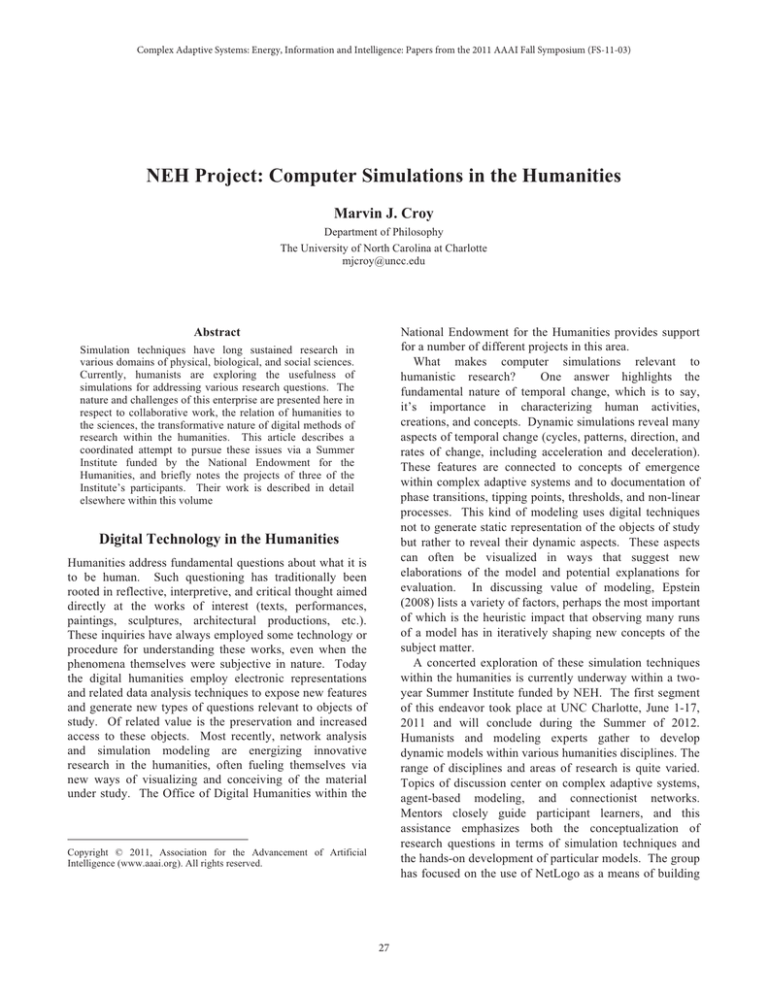
Complex Adaptive Systems: Energy, Information and Intelligence: Papers from the 2011 AAAI Fall Symposium (FS-11-03)
NEH Project: Computer Simulations in the Humanities
Marvin J. Croy
Department of Philosophy
The University of North Carolina at Charlotte
mjcroy@uncc.edu
National Endowment for the Humanities provides support
for a number of different projects in this area.
What makes computer simulations relevant to
humanistic research?
One answer highlights the
fundamental nature of temporal change, which is to say,
it’s importance in characterizing human activities,
creations, and concepts. Dynamic simulations reveal many
aspects of temporal change (cycles, patterns, direction, and
rates of change, including acceleration and deceleration).
These features are connected to concepts of emergence
within complex adaptive systems and to documentation of
phase transitions, tipping points, thresholds, and non-linear
processes. This kind of modeling uses digital techniques
not to generate static representation of the objects of study
but rather to reveal their dynamic aspects. These aspects
can often be visualized in ways that suggest new
elaborations of the model and potential explanations for
evaluation. In discussing value of modeling, Epstein
(2008) lists a variety of factors, perhaps the most important
of which is the heuristic impact that observing many runs
of a model has in iteratively shaping new concepts of the
subject matter.
A concerted exploration of these simulation techniques
within the humanities is currently underway within a twoyear Summer Institute funded by NEH. The first segment
of this endeavor took place at UNC Charlotte, June 1-17,
2011 and will conclude during the Summer of 2012.
Humanists and modeling experts gather to develop
dynamic models within various humanities disciplines. The
range of disciplines and areas of research is quite varied.
Topics of discussion center on complex adaptive systems,
agent-based modeling, and connectionist networks.
Mentors closely guide participant learners, and this
assistance emphasizes both the conceptualization of
research questions in terms of simulation techniques and
the hands-on development of particular models. The group
has focused on the use of NetLogo as a means of building
Abstract
Simulation techniques have long sustained research in
various domains of physical, biological, and social sciences.
Currently, humanists are exploring the usefulness of
simulations for addressing various research questions. The
nature and challenges of this enterprise are presented here in
respect to collaborative work, the relation of humanities to
the sciences, the transformative nature of digital methods of
research within the humanities. This article describes a
coordinated attempt to pursue these issues via a Summer
Institute funded by the National Endowment for the
Humanities, and briefly notes the projects of three of the
Institute’s participants. Their work is described in detail
elsewhere within this volume
Digital Technology in the Humanities
Humanities address fundamental questions about what it is
to be human. Such questioning has traditionally been
rooted in reflective, interpretive, and critical thought aimed
directly at the works of interest (texts, performances,
paintings, sculptures, architectural productions, etc.).
These inquiries have always employed some technology or
procedure for understanding these works, even when the
phenomena themselves were subjective in nature. Today
the digital humanities employ electronic representations
and related data analysis techniques to expose new features
and generate new types of questions relevant to objects of
study. Of related value is the preservation and increased
access to these objects. Most recently, network analysis
and simulation modeling are energizing innovative
research in the humanities, often fueling themselves via
new ways of visualizing and conceiving of the material
under study. The Office of Digital Humanities within the
Copyright © 2011, Association for the Advancement of Artificial
Intelligence (www.aaai.org). All rights reserved.
27
dynamic, agent based models. Gilbert and Troitzsch’s
Simulation for the Social Scientist (2005) and Drucker’s
SPECLAB: Digital Aesthetics and Projects in Speculative
Computing (2009) can provide both technical and
conceptual background for such projects. The projects of
three participant humanists (Gillian Crozier, Graham Sack,
and Stephen Crowley) are described in separate articles
within this volume. Crozier’s research addresses the
mechanisms of cultural evolution. Her simulations suggest
new informative field experiments and specific ways of
improving current models. Sack articulates the narrative
structure of 19th century British novels by modeling
various features of plot and character development. Here,
too, the cumulative impact of iterative development is
evident. Crowley analyzes the conceptual and
communicative mechanisms that undergird crossdisciplinary research. As seen below, modeling projects
often draw upon the resources of various disciplines. The
progress made within these investigations is representative
of what has thus far been achieved by many of the Summer
Institute participants.
Discussions and presentations at the Summer Institute
include critical reflection upon the methods and scope of
humanities research. This reflection revolves around the
value of collaborative research, the relation between the
sciences and the humanities, and the transformative
potential of the digital humanities. These issues are
inseparable, and discussion of one inevitably leads to the
others. For organizational purposes, these topics will next
be taken up sequentially, but the cyclical nature of the
discussion is not only inherent but logically mandated.
existence is simultaneously a conceptual, empirical, and
pragmatic enterprise. New ways of thinking intertwine
with scientific perspectives and findings (changeable as
they are) and with efforts to improve the human condition.
On another level, the concerns of humanists and social
scientists may converge upon the same phenomena from
different routes (economic, political, cultural, etc.).
Working in modeling groups varied by discipline provides
helpful ways of coming to see one’s own inquiry as a
promising modeling project. In some cases, this will
involve the heuristic impact of readily visualized
quantitative change.
Science or Humanities?
The advent of simulation techniques is contributing to the
growth of digital humanities. Only a decade ago, Anthony
Kenny of the British Academy could write that “the
research methods of social scientists have been
transformed by the use of the computer; the humanities
have been comparatively unaffected” (Kenny 1999).
Exploring the applicability of networks and simulations are
among the newer technologies that have contributed to the
increased use of computers in humanities research. This
usage necessarily confronts issues concerning the portrait
of humankind painted by various scientific traditions, the
relevance/irrelevance of scientific methods (particularly
quantitative), and the value of the knowledge produced by
each tradition. Social sciences are routinely taken to be
part of the humanities, given their focus on human
interaction and resulting phenomena, but quantitative
methods can be narrowly focused and often in need of
interpretation. Nevertheless, the key issue here concerns
the ways in which quantitative characterizations of change
can contribute towards and widen the scope of alternative
perspectives within humanities research. But is this
humanities or science? While some may see this as an
exclusive disjunction, the answer is clearly “both.”
Science and the humanities are separate only if each is seen
as finite and undeniable. Both, however, are in process
and continually contributing to the comprehension of the
other. In general, intellectual inquiry transforms itself via
interactive conceptual and empirical processes of
elaboration and criticism.
Neither science nor the
humanities provides an exception.
Collaborative Research
Within the humanities there has been less collaboration
than within the sciences, and there has been more
resistance to the use of digitally based methods of research
(Palmer and Neumann 2002; Anderson 2004). Arguably,
the use of simulation methods can be a force for increased
cooperative research. Adopting new technical methods of
investigation inevitably leads to collaboration with experts
in other disciplines. This is obvious in respect to technical
advice and/or support for implementing a computer model
using some particular tool. Beyond this, collaboration with
modeling experts facilitates articulation of basic concepts
(‘complex adaptive system’, ‘network’, ‘agents’, etc.)
within a particular modeling enterprise. This articulation
can be promoted by understanding the progress of similarly
motivated colleagues and modelers in other disciplines.
Digital humanities research naturally leads to
interdisciplinary inquisitiveness and makes evident the
underlying tension/connection between the humanities and
the sciences. Understanding the complexities of human
The Transformative Nature of Digital
Technology in the Humanities
Proposing new methods of investigation within an
established research program will raise questions about
proper application and the significance of results produced.
28
Melanie Mitchell, Portland State University; Matthias
Scheutz, Indiana University; Eric Sauda, UNC Charlotte;
Tim Tangherlini, UCLA; Paul Youngman, UNC Charlotte.
In particular, the issue is whether the results of the new
methods advance the original inquiry or substitute new but
irrelevant questions (those easily addressed by the new
method). Advances within the digital humanities are
increasingly raising such questions. It is obvious that any
data structure renders an abstraction, as does any
representation, and data structures of various types are
increasingly being used within humanities research
(Moretti 2007).
However, the issue here concerns
implications of new methodologies that recast the basic
aims and assumptions of an entire discipline. This issue is
taken on by humanists who are directly involved in the
technological explorations of digital research (Deyrup
2009; Berry 2011). Confronting such self-reflective,
methodological questions is crucial for the health of any
intellectual enterprise.
References
Anderson, D. ed. 2004 Digital Scholarship in the Tenure,
Promotion, and Review Process. Armonk, N.Y.: M.E. Sharpe.
Berry, D. 2011. The Philosophy of Software: Code and Mediation
in the Digital Age. London: Palgrave Macmillan.
Coppock, T. ed. 1999. Information Technology and Scholarship:
Applications in the Humanities and Social Sciences. Oxford:
Oxford University Press.
Deyrup, M. ed. 2009. Digital Scholarship. New York: Routledge.
Epstein, J. 2008. Why Model?. Journal of Artificial Societies and
Social Simulation 11(4): 12.
Drucker, J. 2009. SPECLAB: Digital Aesthetics and Projects in
Speculative Computing. Chicago: University of Chicago Press.
Kenny, A. 1999. Scholarship and Information Technology. In
Information Technology and Scholarship; Applications in the
Humanities and Social Sciences. Oxford: Oxford University
Press.
Acknowledgements
This project is funded by a grant from the National
Endowment for the Humanities, Institutes for Advanced
Topics in the Digital Humanities, HT-50030-10.
Moretti, F. 2007. Graphs, Maps, Trees: Abstract Models
for a Literary History. London: Verso.
Gilbert, N., and Troitzsch, K. 2005. Simulation for the
Social Scientist, second ed. Berkshire: Open University
Press.
Palmer, C. and Neumann, L. 2002. The Information Work
of Interdisciplinary Humanities Scholars: Exploration and
Translation. Library Quarterly 72: 85-117.
Investigators for this project include Anthony Beavers,
Evansville University; Marvin Croy, UNC Charlotte;
Patrick Grim, Stony Brook University; Mirsad Hadzikadic,
UNC Charlotte; and Paul Youngman, UNC Charlotte.
Participants include Marshall Abrams, University of
Alabama Birmingham; Markus Christen, University of
Zürich; Stephen Crowley, Boise State University; Gillian
Crozier, Laurentian University; Rogier De Langhe, Ghent
University; Marten Duering, Universität Essen; Dana
Downey, George Mason University; Stefano Giaimo,
European Institute of Oncology; Peter Gildenhuys,
Lafayette University; Ruth Poproski, Carnegie-Mellon
University; Hilton Root, George Mason University;
Graham Sack, Columbia University; Teresa Satterfield,
University of Michigan; Harsh Satya, International
Institute of IT; Jeremy Throne, UC Santa Cruz; and Scott
Weingart, Indiana University.
Mentors include Jason Alexander, London School of
Economics; Aaron Bramson, Independent Scholar; Derek
Burrows, Evansville University; Ted Carmichael, UNC
Charlotte; Christopher Harrison, Evansville University;
Nicolas Payette, University of Quebec; Jason Rines, UNC
Charlotte; Daniel Singer, University of Michigan, and
Charles Turnitsa, Old Dominion University.
Keynote presenters include Katy Börner, Indiana
University; Deborah Bosley, UNC Charlotte; Boyd Davis,
UNC Charlotte; Johanna Drucker, UCLA; Liz Johnson,
UNC Charlotte; Paul Humphreys, University of Virginia;
29





